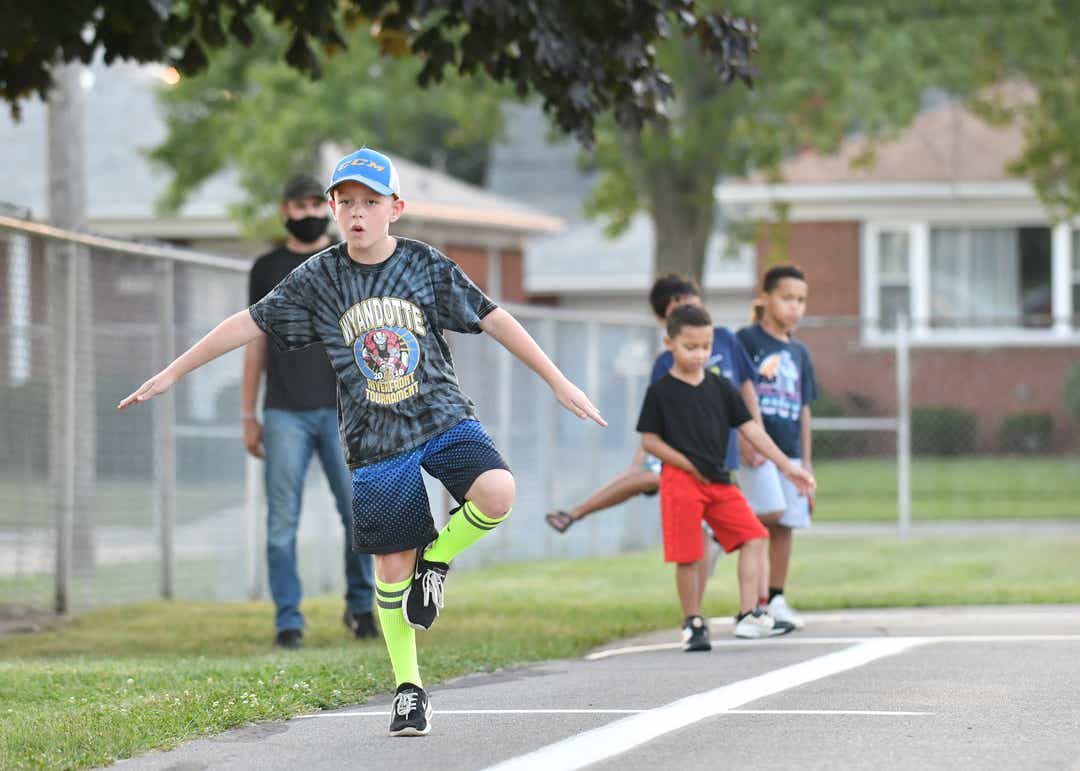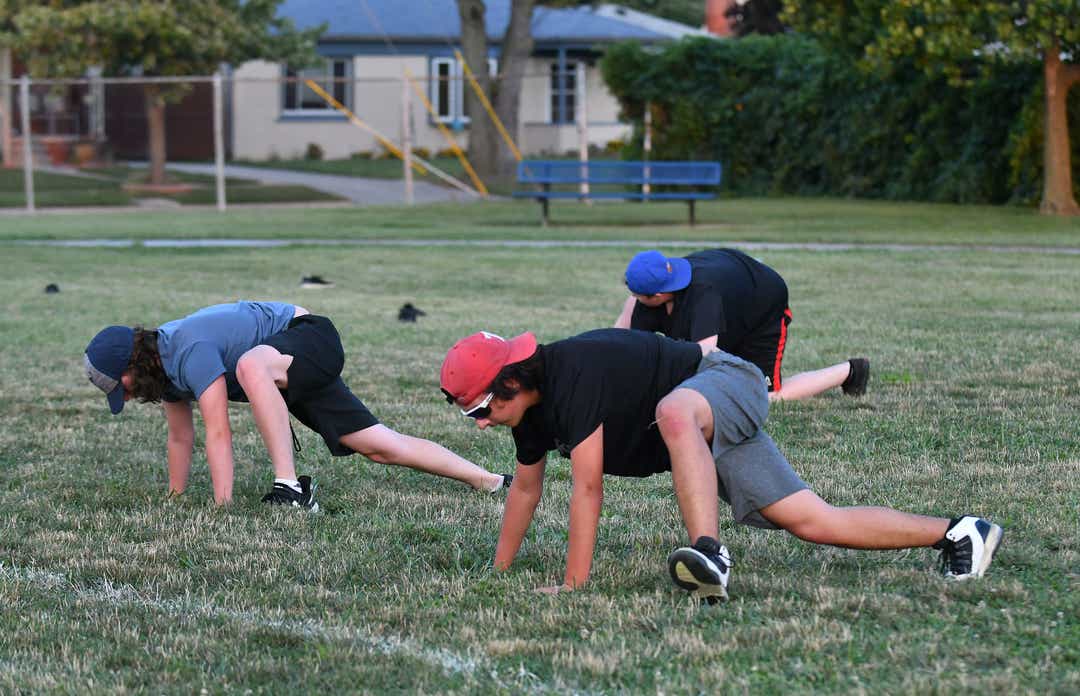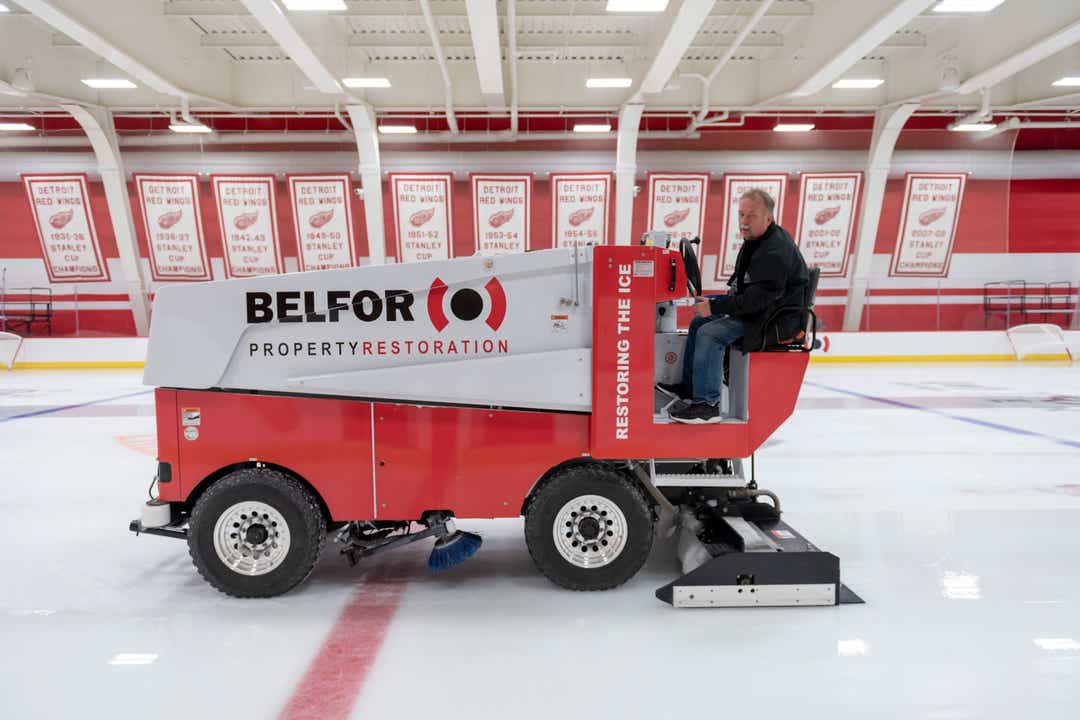Wyandotte – The skates, sticks, pads, socks and helmets are coming out of hibernation.
Brendan Pace and the rest of his Wyandotte Warriors teammates can slide the sneakers to the side.
No more training on land. It’s time to return to the ice.
“Overdue” said Pace, of Gov. Gretchen Whitmer’s decision last week to open up ice rinks, and essentially start up the hockey season, after having COVID-19 shut things down since March. “It was a maybe a bit overdue.
“Everyone is pumped to get back out there.”

The announcement by Whitmer gave the green light to a bunch of youth sports. But the start of hockey brought about a different type of enthusiasm.
There were almost 50,000 registered youth, adult and disabled players in Michigan last year, with more than 600 teams under the umbrella of the Little Caesars Amateur Hockey League alone.
In Michigan, it doesn’t take long to find someone involved in hockey. Most of the time it’s from actually playing or having someone related who is playing.
“Hockey people are very passionate about the sport,” said Lyle Phair, managing director of the Suburban Hockey School and president of the Honeybaked Hockey Club.
And that made the return to play a feeling like scoring a winning goal in overtime.
But the sport they are returning to is going to look different. Not necessarily on the ice, but in the rinks, for the spectators – those few that are going to be allowed inside.
And overall there’s probably going to be fewer players, too.
But hockey players are finally getting that chance to play.
“We just want to be able to get things opened back up,” said George Atkinson, president of the Michigan Amateur Hockey Association (MAHA). “I believe we can open up and be at a very safe level. Like people going to a store, there’s a way to do it properly and safely.”
Long summer
The Wyandotte Hockey Association has been having land training multiple times per week, what with no ice at Yack Arena.
Turnouts have been steady, even increasing. With that nip in the air some days, it’s a reminder hockey is on the horizon.
But many of the Metro Detroit rinks, including Yack, haven’t even had ice inside, not knowing when the season would get the go-ahead from the state.

“It’s been a long, frustrating wait,” said Pace, whose Warriors are still at least another week from an actual practice before the ice gets done at Yack. “Usually, we’d have been already a couple week into (practices). But this season, we’ve done nothing.
“Land training, stuff like that. That’s all.”
The land training was fine for a while, but there was greater anticipation of actually doing something with sticks and pucks on the ice.
“From the first (land) training, we’ve probably felt like that,” Pace said.
With options severely limited in Michigan – there were reports of some suburban rinks open in the Metro Detroit area for open skating and loosely organized hockey activities – many families went to Ohio or Indiana for their hockey fix.
Or to Traverse City or the Upper Peninsula, in Regions 6 and 8 in the state, which were opened by Whitmer early in the summer and have been doing hockey business as usual.
“It’s just been a really, really tough spot for everyone,” said Joe Emery, commissioner of Little Caesars Hockey. “You’d hear of people having to travel to Ohio just to get an hour of ice. Just to go down there to skate. It’s just weird, the difference state by state.
“My son is a junior hockey player who went out east this summer and couldn’t skate in Boston – but could in Connecticut and New Hampshire.
“Just like here.”
Youth camps and clinics around the southern Lower Peninsula – so popular and filled to capacity usually in the summer – didn’t take place. Ice was never put in at Belfor Training Center at Little Caesars Arena, the practice rink for the Red Wings and also a hotbed for Little Caesars hockey for various summer hockey activities.

Summer league games weren’t played. Tryouts were delayed or postponed.
But now it’s time to get going.
“We have plans in place to run a complete league for the 2020-21 season, including playoffs,” Emery said. “It’ll probably be a little condensed given the timelines. But we’re ready. Everyone has been waiting.”
Hockey up north
Since around June, hockey business has been going on as normal from about Gaylord and north from there.
In Traverse City, always a hockey hotbed, the Centre Ice Arena has been busy, said Todd Spaulding, executive director of operations.
“We started slow but it’s been pretty steady,” Spaulding said. “Our youth hockey has just started up. We just had tryouts.”
The Grand Traverse Hockey Association, said Spaulding, has been diligent about distancing people in the locker room and around the rink. Temperatures were taken every day during the tryouts. Cleanliness and health has been first and foremost on everyone’s mind.
“Little stuff that we took for granted before, not anymore,” Spaulding said.
Spaulding said he’s heard of teams and individuals from the southern part of the state renting ice in Traverse City and practicing.
The stories of teams spending days in other parts of northern Michigan getting some summer workouts in are also prevalent among the hockey community.
Participation in clinics in Traverse City stayed steady compared to previous years, said Spaulding, as only one camp had to be cancelled due to a sparse turnout.
And the best news? There were no reported cases of COVID-19 from those camps.
But Spaulding has heard of virus incidents near the rink since then, which gives pause to everyone in the community and the sport that being constantly on guard is crucial.
“It’s just so hard to know who is walking around with it and who isn’t,” Spaulding said.
Still, the success in Traverse City and the UP this summer has other hockey people encouraged.
“Rinks have been open and it’s been shown it can be done safely and responsibly,” Phair said. “It’s been proven all over the country.”
Spaulding is excited about hockey opening up about the rest of the state, not just in his part of the state but everywhere else.
“It’s not just youth hockey,” Spaulding said. “In general, people are hoping to get back to normal. Watching your kids be involved, like in hockey, it’s all part of getting back to normal.
“Hopefully all of it can be done in a safe way.”
What to expect
The game on the ice won’t change. But away from the ice there will be some tweaks.
MAHA is expected to send its directives later this week, but generally, the rinks that have been open this summer, and the ones planning to open in the days ahead, know what to expect or have been doing it already.
►Social distancing around the rink, with masks required for all parents and rink personnel, and players when they aren’t on the ice.
►Gatherings in lobbies will be a thing of the past, and many concession stands could be shut down or minimized.

►Some rinks or leagues might require temperature checks of players.
►Players should expect to arrive at rinks mostly geared up. Use of locker rooms will be restricted to small groups, with few rinks likely to prohibit showers after games.
►While exact figures are yet to be finalized, most rinks will only be allowed 10 to 25 percent of usual capacity.
Each local association will get the directive from MAHA, then add to it if necessary, given any sort of directives from the individual region or rink.
“The rinks may have their own guidelines, so we have to make sure everything, everyone, falls in line,” said Christina Mincey, a manager in the Wyandotte Hockey Association. “It all has to mesh so everyone is on the same page.
“Safety will be a priority.”
But on the ice, things aren’t likely to change. You can expect battle drills, live scrimmages and full contingent of players and coaches on the ice.
“The game itself, the way the game is played, nothing really changes,” Atkinson said. “Players wear full protection. They don’t touch the object in play. It’s really more a game of keep away.
“It strikes me as funny that some of these states are categorizing hockey as high-risk sport. The perception is there because of the body contact, people associate it with football. But it’s nowhere near the same thing.”
Said Phair: “In football everybody converges on the ball and piles up. You’re playing with one ball that is everybody is touching with their hands. But in hockey, you’re using a stick, handling a puck.
“I don’t think there’s a whole lot of potential for transmission on the ice because it’s a 17,000-square foot area with 12 people on it. By its nature, hockey is a safer sport than a lot of others. Everyone is wearing a full suit of protective equipment and you’re trying to go to space, not traffic, in a lot of cases.”
Will numbers drop?
MAHA supervises activities of more than 2,500 amateur hockey teams and approximately 50,000 players and coaches.
Atkinson hopes the pandemic isn’t going to dramatically cut into participation. Surveys done over the summer, said Atkinson, show a possible 2-percent drop.
“But we’re one of the only states where the rinks haven’t been open,” Atkinson said. “If you can’t go play, there’s no sense paying the money to sign up. There’s going to be a small number (of families not returning to hockey).”
Health concerns in families, many school districts switching to online rather than in-person learning, and simply having concerns about the rinks themselves could keep boys and girls off the ice.
“There’s a lot of different reasons for it; it’s going to negatively impact all youth sports,” Phair said. “It’s had a negative impact on everyone’s life. We’ll have to deal with it.”
But more so than the virus itself, hockey officials believe the economy will be the key reason if participation numbers dwindle.
Mincey, from Wyandotte, said several families have indicated they might not return to hockey because they have jobs in industries that have yet to re-open in Michigan and may not be economically capable of having kids play hockey.
But, said Mincey, COVID-19 wasn’t a concern.
“In the ’90s the auto industry was booming and the Red Wings were winning Stanley Cups and I can think of about 20 rinks off the top of my head in the Detroit area that were opened up,” Phair said. “There was a huge uptick (in participation). Hockey was booming.
“As 2008 hit (during the recession), things dropped off. A lot of families moved out of state. There was a decline in participation.
“Now, a good chunk of the economy has been shut down for a while; a lot of people are losing jobs or will lose their job. The economics part of it is going to hit us in a year, or six months. I don’t think it’s fully impacted us yet.”
But last Thursday, all the talk about hockey was positive. The game was back on, and everyone was excited.
“You could see the excitement, kids were jumping out of the cars knowing they’ll be able to start skating soon,” Mincey said.
The sound of pucks banging against boards inside rinks will again be common.
“It’s been a long wait,” Pace said. “That’s almost all we talked about when we (the team) got together in these workouts: ‘When are we going to play?’”
ted.kulfan@detroitnews.com
Twitter: @tkulfan